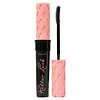What's inside
What's inside
 Key Ingredients
Key Ingredients

 Benefits
Benefits

 Concerns
Concerns

 Ingredients Side-by-side
Ingredients Side-by-side

Isododecane
EmollientCera Microcristallina
Emulsion StabilisingCera Alba
EmollientC8-9 Isoparaffin
SolventDisteardimonium Hectorite
StabilisingCopernicia Cerifera Cera
EmollientWater
Skin ConditioningPropylene Carbonate
SolventAllyl Stearate/Va Copolymer
Lecithin
EmollientSilica
AbrasiveSodium Polymethacrylate
Emulsion StabilisingHydrogenated Jojoba Oil
AbrasivePhenoxyethanol
PreservativePEG/PPG-17/18 Dimethicone
EmulsifyingEthylenediamine/Stearyl Dimer Dilinoleate Copolymer
Skin ConditioningEthylparaben
PreservativePolyvinyl Laurate
Polyquaternium-10
Soluble Collagen
HumectantPanthenol
Skin ConditioningPropylparaben
PreservativeIsobutylparaben
AntimicrobialMethylparaben
PreservativeButylparaben
MaskingOryza Sativa Starch
AbsorbentCI 77499
Cosmetic ColorantCI 77492
Cosmetic ColorantCI 77491
Cosmetic ColorantCI 77007
Cosmetic ColorantCI 77891
Cosmetic ColorantCI 75470
Cosmetic ColorantCI 77289
Cosmetic ColorantCI 77742
Cosmetic ColorantCI 77510
Cosmetic ColorantMica
Cosmetic ColorantIsododecane, Cera Microcristallina, Cera Alba, C8-9 Isoparaffin, Disteardimonium Hectorite, Copernicia Cerifera Cera, Water, Propylene Carbonate, Allyl Stearate/Va Copolymer, Lecithin, Silica, Sodium Polymethacrylate, Hydrogenated Jojoba Oil, Phenoxyethanol, PEG/PPG-17/18 Dimethicone, Ethylenediamine/Stearyl Dimer Dilinoleate Copolymer, Ethylparaben, Polyvinyl Laurate, Polyquaternium-10, Soluble Collagen, Panthenol, Propylparaben, Isobutylparaben, Methylparaben, Butylparaben, Oryza Sativa Starch, CI 77499, CI 77492, CI 77491, CI 77007, CI 77891, CI 75470, CI 77289, CI 77742, CI 77510, Mica
Water
Skin ConditioningParaffin
PerfumingPolybutene
Cera Alba
EmollientBis-Diglyceryl Polyacyladipate-2
EmollientPalmitic Acid
EmollientStearic Acid
CleansingVp/Eicosene Copolymer
Acacia Senegal Gum
MaskingCopernicia Cerifera Wax
Aminomethyl Propanediol
Buffering1,2-Hexanediol
Skin ConditioningCaprylyl Glycol
EmollientSilica
AbrasiveEuphorbia Cerifera Wax
Hydroxyethylcellulose
Emulsion StabilisingPanthenol
Skin ConditioningButylene Glycol
HumectantHydroxyacetophenone
AntioxidantChlorphenesin
AntimicrobialPentylene Glycol
Skin ConditioningTocopheryl Acetate
AntioxidantAlgin
MaskingSerine
MaskingDisodium Phosphate
BufferingSodium Phosphate
BufferingPolysorbate 60
EmulsifyingIron Oxides
Water, Paraffin, Polybutene, Cera Alba, Bis-Diglyceryl Polyacyladipate-2, Palmitic Acid, Stearic Acid, Vp/Eicosene Copolymer, Acacia Senegal Gum, Copernicia Cerifera Wax, Aminomethyl Propanediol, 1,2-Hexanediol, Caprylyl Glycol, Silica, Euphorbia Cerifera Wax, Hydroxyethylcellulose, Panthenol, Butylene Glycol, Hydroxyacetophenone, Chlorphenesin, Pentylene Glycol, Tocopheryl Acetate, Algin, Serine, Disodium Phosphate, Sodium Phosphate, Polysorbate 60, Iron Oxides
 Reviews
Reviews

Ingredients Explained
These ingredients are found in both products.
Ingredients higher up in an ingredient list are typically present in a larger amount.
Cera alba is beeswax, or the wax used by bees to make honeycombs. It is a texture-enhancer and emollient. A study from 2003 found beeswax to be a stronger emollient than ingredients such as petroleum jelly.
As an emollient, beeswax helps hydrate the skin by creating a barrier on top. This barrier traps moisture in.
Emulsifiers help prevent ingredients from separating. This helps create consistent texture.
The structure of beeswax is mainly long-chain alcohols and the esters of fatty acids.
There are three types of beeswax: yellow, white, and absolute. Yellow is pure beeswax taken from the honeycomb. White beeswax is created by filtering or bleaching yellow beeswax. Absolute beeswax is created by treating beeswax with alcohol. Beeswax used in cosmetics are purified.
Beeswax has been used throughout history and even in prehistoric times. Some common uses for beeswax still used today are making candles, as a waterproofing agent, and polish for leather.
Learn more about Cera AlbaPanthenol is a common ingredient that helps hydrate and soothe the skin. It is found naturally in our skin and hair.
There are two forms of panthenol: D and L.
D-panthenol is also known as dexpanthenol. Most cosmetics use dexpanthenol or a mixture of D and L-panthenol.
Panthenol is famous due to its ability to go deeper into the skin's layers. Using this ingredient has numerous pros (and no cons):
Like hyaluronic acid, panthenol is a humectant. Humectants are able to bind and hold large amounts of water to keep skin hydrated.
This ingredient works well for wound healing. It works by increasing tissue in the wound and helps close open wounds.
Once oxidized, panthenol converts to pantothenic acid. Panthothenic acid is found in all living cells.
This ingredient is also referred to as pro-vitamin B5.
Learn more about PanthenolSilica, also known as silicon dioxide, is a naturally occurring mineral. It is used as a fine, spherical, and porous powder in cosmetics.
Though it has exfoliant properties, the function of silica varies depending on the product.
The unique structure of silica enhances the spreadability and adds smoothness, making it a great texture enhancer.
It is also used as an active carrier, emulsifier, and mattifier due to its ability to absorb excess oil.
In some products, tiny microneedles called spicules are made from silica or hydrolyzed sponge. When you rub them in, they lightly polish away dead skin layers and enhance the penetration of active ingredients.
Learn more about SilicaWater. It's the most common cosmetic ingredient of all. You'll usually see it at the top of ingredient lists, meaning that it makes up the largest part of the product.
So why is it so popular? Water most often acts as a solvent - this means that it helps dissolve other ingredients into the formulation.
You'll also recognize water as that liquid we all need to stay alive. If you see this, drink a glass of water. Stay hydrated!
Learn more about Water